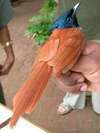Genus Terpsiphone

Japanese Paradise-Flycatcher - The Japanese Paradise-flycatcher is mainly migratory and breeds in shady mature deciduous or evergreen broadleaf forest of Japan , South Korea, Taiwan and the far north Philippines. It is a non-breeding visitor to mainland China, Hong Kong, Thailand, Laos, Vietnam, Philippines, Malaysia, Singapore, and Sumatra, Indonesia.
Bedford's Paradise Flycatcher - The Bedford's Paradise-flycatcher is a species of bird in the Monarchidae family. It is endemic to Democratic Republic of the Congo.
Mascarene Paradise Flycatcher - It is found in Mauritius and Réunion. Its natural habitat is subtropical or tropical moist lowland forests.
Seychelles Paradise Flycatcher - The length of the males is about 20 cm. In addition there are two long black central tail feathers which can reach a length of 30 cm. The females can reach a length between 16 and 18 cm . The males are entirely glossy black with a deep blue sheen. The upperparts of the females including wings and tail are reddish brown. The underparts are pale cream white. Facial skin, bill, and legs are blue.
Blue Paradise Flycatcher - The Blue Paradise-flycatcher is a species of bird in the Monarchidae family. It is endemic to the Philippines.
Asian Paradise-Flycatcher - The Asian Paradise-flycatcher , also known as the Common Paradise-flycatcher, is a medium-sized passerine bird. It was previously classified with the Old World flycatcher family Muscicapidae, but the paradise-flycatchers and monarch flycatchers are now placed in the family Monarchidae, and most members of this family are found in Australasia and tropical southern Asia.
Black-headed Paradise-Flycatcher - However, the Red-bellied Paradise-flycatcher is a common resident breeder in tropical western Africa south of the Sahara Desert. This species is usually found in thick forests and other well-wooded habitats. Two eggs are laid in a tiny cup nest in a tree.
African Paradise Flycatcher - The African Paradise Flycatcher is a common resident breeder in Africa south of the Sahara Desert. This species is usually found in open forests and savannah habitats. Two or three eggs are laid in a tiny cup nest in a tree.




